
 |
|
TO PAGE: 1 • 2 • 3 • 4 • 5 • 6 • 7 • 8 • 9 • 10 • 11 • 12 • 13 • 14 • 15 |
![]()
CAREER
|
Together with the Ellery Queen books the character of Ellery Queen changed. And what did we get? Romance... they treated us to affaires of the heart. Our by Queen battered brain got some romantic elements to consider. The first novels being very down to earth, the subsequent were very grave and metaphysical and at a certain moment Ellery Queen gave his stories a warm heartbeat. Some of the less cerebral readers had stated a wish for Ellery not being so alienated from day to day life. The murderer must be very shrewd but there had to be a limit somewhere for human machinations and a criminal's strategy. Queen's speech pattern was more American slang than American formal, and he began to worry that he might be too quick with his solutions. His investigations began to affect other people's lives. They only published five novels and the three-act stage play Danger, Men Working (base for the movie The Crime Nobody Saw) The latter (Rev. version of Shot in the Dark) coauthored with Lowell Brentano, premiered at Baltimore's Auditorium Theatre on February 6. 1936. The action - sans Ellery Queen manifested on a revolving stage - begins in a Greenwich Village apartment. Their play has to do with three mystery story writers incarcerated in a Twelfth Street house collaborating on a thriller. Unable to agree on a plot, they are overjoyed when a real honest-to-goodness murder occurs in their midst. Instead of notifying headquarters, as all good citizens should they endeavor to solve the mystery themselves before the police arrive. Ellery Queen (the author) attended the rehearsals, the play had Hal K. Dawson in the leading role. The play moved to Philadelphia, where it was disbanded after a few performances. Fortunately someone in Hollywood got interested ... |
|
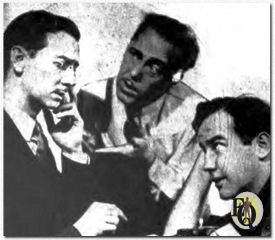 Right: Fred Stewart, Hal K. Dawson and Broderick Crawford the principal
players of Danger Men Working, a new murder mystery opening at
the Broad tomorrow, engage in deep discussion. The cast is comprised of
Hal K. Dawson, Broderick Crawford. Fred Stewart. Flora Campbell, Philip
Huston, Stanley Jessup, Herbert Warren, Kenneth Hunter, Edward Butler,
Jane Bancroft, Helen Henry, Lee Cobb, Eulabelle Moore. The play has been
directed by Burke Symon (Feb 9. 1936) Right: Fred Stewart, Hal K. Dawson and Broderick Crawford the principal
players of Danger Men Working, a new murder mystery opening at
the Broad tomorrow, engage in deep discussion. The cast is comprised of
Hal K. Dawson, Broderick Crawford. Fred Stewart. Flora Campbell, Philip
Huston, Stanley Jessup, Herbert Warren, Kenneth Hunter, Edward Butler,
Jane Bancroft, Helen Henry, Lee Cobb, Eulabelle Moore. The play has been
directed by Burke Symon (Feb 9. 1936) |
|
|
We found a late 1936 newspaper article in which Ellery Queen ("He is two people,...") is hailed as the new writer for an upcoming Randolph Scott movie Betting Fever (Paramount) with Barney Glazer as producer and J. Theodore Reed as director. This movie about horse racing was their first Hollywood assignment. However no such movie was ever made. By November 19. 1936 Paramount had purchased Danger, Men Working, mystery story with many comedy situations written by Manfred Lee, Fred Dannay and Lowell Brentano it became The Crime Nobody Saw (Paramount, Mar 12. 1937). They made it to the West Coast by train as the following anecdote from a 1936 newspaper illustrates: "... The two authors are now at Paramount writing for the movies. On their way out here, they made a train acquaintance, a congenial spirit, and the trio often played cards together. It was as the train was nearing Los Angeles that the big shock came. Dannay and Lee went to tell the acquaintance goodbye and discovered him handcuffed to two men. He was wanted on the coast for bigamy." On October 12. 1936 The Film Daily announced Ellery Queen's presence in Tinseltown as follows: "A lot of you lads will recall Manny Lee who worked in the publicity dep't. Manny was a swell copy writer and layout man but he had a yen to write detective fiction he collaborated with his cousin and they worked and experimented together nights and week-ends, till finally they developed a detective-murder-mystery technique today they are world-famous under the nom-de-plume of Ellery Queen. They have just gone to Hollywood under a nice writing contract for the Paramount studio. What makes us smile is that Manny used to bemoan the fact to us that none of the majors would buy his original scripts "They've put a label on me," Manny said, "I'm just a good copywriter to them" now ain't that a laugh? |
|
|
The reason for the rather thin output was the fact that they had been hired by Hollywood as screenwriters at the story departments of three different studios: Columbia, Paramount and M.G.M. Little is known about this less successful period in their careers. The first assignment they got from Hollywood was to write a screenplay about a horse race. The story was adapted into the short story "Long Shot" (Blue Book, 1939) The cousins themselves never elaborated much on any of the work they did in Hollywood claiming they didn't remember much. But Hollywood did take notice of the special working relationship. Paramount had fitted out a single office in it's writers' building. "Paramount executives are wondering what to do with Frederic Dannay and Manfred Lee, who collab under the moniker of Ellery Queen, brought out to the Coast to concentrate on a whodunit. When lads get down to work they almost scrap fistically, as well as verbally, and rouse other writers from their lethargy. Studio execs figuring how soundproof quarters would work." (Variety, Wednesday Oct 21. 1936) |
|
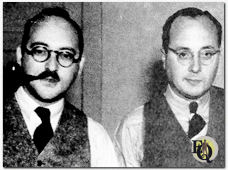 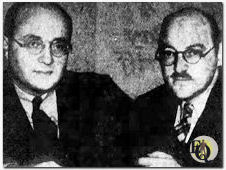 Above left: Ellery Queen, author turns out to be couple of other fellows. Frederic Dannay (left) and Manfred Lee - Hollywood discovered they were Ellery Queen (Jan 1937). Above right: The caption under this 1938 photo read: "Frederic Dennay, left, and Manfred B. Lee, right, conferring on an Ellery Queen plot" (sic). It should have read: "Frederic Dannay, right, and Manfred B. Lee, left conferring on an Ellery Queen plot" |
|
|
Their highly argumentative methods of working together caused friction with people in the neighboring offices and, while the pay was lucrative, they did not write anything that earned them a screen credit. So after trying their luck on stage and movies another medium would come to their rescue. A medium for the masses about to hit his own "Golden Age": radio. |
|
|
They were contacted by a young executive at the Columbia Broadcasting System (CBS) who was looking for someone who could write a new sort of radio-drama: an hour-long detective series. George Zachary offered them 250-350$ a week and an own radio show, still they felt reluctant to accept. One can only suspect they finally preferred the vast potential audience it offered. The learned the ropes writing for radio writing for several radio shows some known some forgotten (even by themselves). Meanwhile preparations where on the way for the Ellery Queen- radio series. During 1939 they must have spend nearly every minute on the radio series, the hectic task of delivering an one-hour original drama each week! So it was no surprise that seven weeks (with two reruns) into 1940 the show was cut to half an hour. Larry Darmour has been credited with signing
Manfred and Frederic to come to Hollywood to work on the first of the
series to be produced for Columbia. This article mentions they were due
to arrive July 15. 1940. |
|
|
Their most known Hollywood contribution
The
Shadow of the Thin Man (MGM, 1941)
didn't warrant screen credit.
Officially Lee returned from L.A. to New York on
May 18. 1941. Dannay arrived a week earlier. Prime matter on their slate
was a pending deal for the return to the air of their radio series. The
deal appears so likely that the authors came on from the Coast to sit in
on the dickering... As Frederic Dannay and Manfred Lee became frustrated with the limitations of the formal deductive puzzle, they tried to break away from tradition and experiment with something else. Why not use the detective story format in a novel that would explore human motivations and relationships? Calamity Town began a new era, the first in a subseries within the Queen canon: the Wrightsville Stories. Read in sequence, the novels of the third period show an inevitable change in Ellery Queen from solver of artificial puzzles to something of a philosopher-detective. Introduced is the angst that infuses the series - especially the Wrightsville novels - of the same period. No more are these "problems in deduction," as the earliest works were defined. Ellery suffers over his cases and their consequences now. He even fails, at times. When Calamity Town was turned down for pre-release by a national magazine for no apparent reason they returned to radio considering it safe to place their bet on several numbers. Theater and movies had proven unsatisfactory and although it was hard work they had much more impact over their radio work. |
|
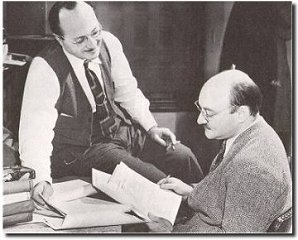 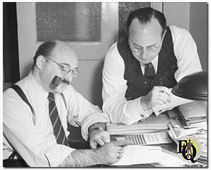 Above left: Lee and Dannay in their EQ office, around 1942. Dannay is reading a radio script. Above right: Dannay and Lee hard at work. |
|
|
In 1943, reportedly, the cousins earned over $50,000 a piece per year, mostly from the radio adventures. Manny and Kaye moved to a charming old rented house at 5 Canon St., Norwalk (Conn.) where they lived with his two daughters by his first wife, Kaye's daughter (Anya) by her first husband and their own newborn daughter Christopher Rebecca. Fred and Mary still lived in Great Neck but Mary had cancer and was bedridden at home. Fred is remembered as keeping to himself and collecting stamps (of animals and ships). During 1943 some reruns were broadcasted and the cousins used the time to write The Murderer is a Fox (1945). |
|
|
In June of 1945 Mary Dannay was near death (she died that year) and Fred had to make arrangements for him and his two sons so he stuck to editing EQMM, some anthologies and the plotting of new Queen-novels. As they had previously done his work for radio was farmed out to Tom Everitt and Anthony Boucher. Boucher being a more religious man brought this aspect to the Queen persona...which was taken over by the cousins e.g. in Ten Day's Wonder (1948). After Mary's death Dannay sold his house and bought another on Carroll Street, Brooklyn, Mary's sister and her husband moved in to take care of the boys. Fred dealt with his grieve as only a workaholic could. In 1947 he remarried Hilda Wiesenthal (a relative of Simon Wiesenthal!), widow of a doctor, Isadore M. Silverman, who died in the Battle of the Bulge in World War II. The newlywed Dannays then bought a small home in the quiet Larchmont on 29 Byron Lane. In April of 1947 as the radio drama moved to Los Angeles, Manny and his family went along. Lee supervised the show. He not only wrote the script but served as a quasi-producer, dealing with radio sponsors, advertising agencies and recalcitrant actors and directors. During the 1947 - 1948 series Kaye Brinker stepped in to play Nikki Porter. But the series came to an end and the family returned to the East Coast making home in suburban Connecticut, first in Westport later on South Street in Roxbury. |
|
|
Manfred started to play a more and more active role in Roxbury's civic live and served a term as justice of the peace there. On a 63 acre estate Manny raised his children, looked after his animals and collected stamps, medals and records. He worked in his study in a converted colonial schoolhouse on his grounds.
Tragedy kept haunting Fred as his wife
Hilda gave birth to
their only child in 1948, the child suffering brain damage at birth would not be able to
walk or talk. Stephen Dannay died six years old. We now find the ground of some
birth-themes in Queen -novels as Cat of Many
Tails
(1949). |
|
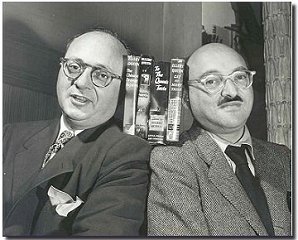 Above: publicity shot of the Ellery Queen team (after 1949) |
|
|
|

|
| Introduction | Floor Plan | Q.B.I. |
List of Suspects | Whodunit? | Q.E.D. | Kill as directed | New | Copyright Copyright © MCMXCIX-MMXXV Ellery Queen, a website on deduction. All rights reserved. |